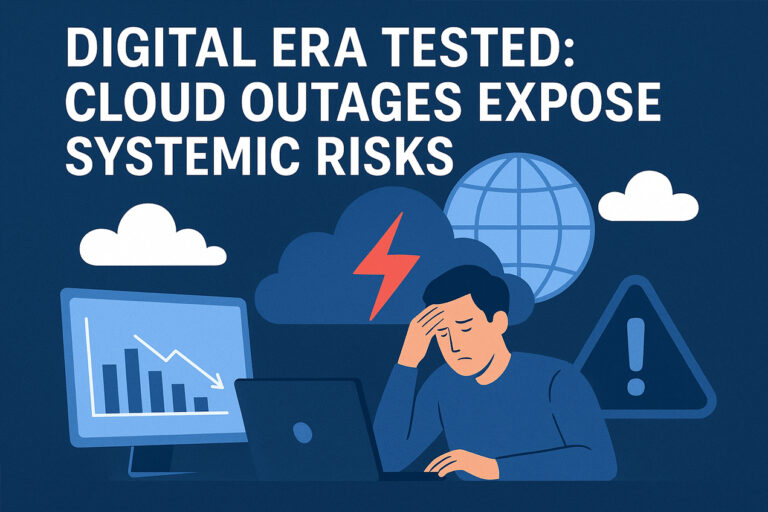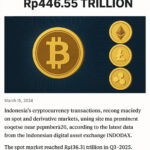Premium Biz Post – In a world driven by technology, recent large-scale cloud outages have revealed how fragile our digital systems are. The digital era tested for businesses, governments, and individuals who depend on constant online access. As companies rush to restore operations, the events highlight a hard truth — our global economy runs on a digital foundation that is far less stable than we think.

The Global Dependence on Cloud Infrastructure
Cloud computing has shifted from a niche tool to the backbone of modern operations. Retail, finance, healthcare, and public services now rely heavily on providers like Amazon Web Services (AWS), Microsoft Azure, and Google Cloud.
Cloud services offer scalability, speed, and lower costs. Yet, this convenience has created dangerous centralization. A single provider’s failure can ripple across the globe. When major networks go down, online stores lose millions, airlines can’t process passengers, and communication platforms freeze.
This heavy dependence has created systemic technological risk — one breakdown can disrupt multiple industries at once.
Recent Outages and Their Ripple Effects
Several recent cloud interruptions show how deeply connected the digital economy has become. Although most outages lasted only hours, their impact was global. Airlines delayed flights, hospitals lost access to patient records, and payment systems stopped working.
For example, an AWS failure in early 2025 halted critical business applications for several Fortune 500 companies. Microsoft Azure’s network issues the same year froze enterprise systems across Europe and Asia.
These events revived concerns about cloud concentration risk — the danger of depending too heavily on a handful of providers. With only a few corporations controlling global data processing, one failure can trigger worldwide disruption.
Systemic Risk: The Hidden Weakness of the Digital Economy
Systemic risk in the digital ecosystem resembles the vulnerabilities seen in finance. Just as one failing bank can destabilize economies, one failing cloud provider could paralyze digital systems globally.
Analysts warn that a 24-hour outage could cause billions in losses and slow supply chains everywhere. Essential services like healthcare, energy, and defense now depend on the cloud. When those systems fail, the effects go beyond inconvenience — they threaten public safety.
The rise of AI, IoT, and smart cities adds new risks. Every connected device depends on cloud data. When networks stop, entire ecosystems stall.
The Domino Effect: How One Failure Spreads Everywhere
Cloud failures rarely stay contained. When one service collapses, its partners and customers soon follow.
Take a payment processor that relies on AWS. If AWS fails, thousands of online stores can’t process transactions. Shoppers lose trust, companies lose revenue, and reputations suffer. A minor outage becomes a global business problem.
Even hybrid or multi-cloud systems aren’t immune. Many share the same underlying technologies like DNS or content delivery networks. When those core services fail, every linked system suffers.
Read More : ”Thick Cotton Rope Functions, Advantages, and Everyday Uses”
Corporate Response and Damage Control
After the latest disruptions, cloud providers issued apologies and technical explanations. Amazon, Microsoft, and Google blamed network misconfigurations or overloads, not cyberattacks. Still, public confidence fell.
Businesses are now rethinking their disaster recovery strategies. Many are adopting multi-cloud environments to spread risk. Others invest in edge computing or localized backups to reduce dependency.
However, redundancy adds cost and complexity. Smaller companies often lack the budget or expertise to manage multiple platforms efficiently.
Government and Regulatory Concerns
Governments have started treating cloud infrastructure as a national concern. Regulators in the EU, the US, and Asia are considering new rules to protect critical services.
The European Union’s upcoming Digital Operational Resilience Act (DORA) will require cloud providers to prove they can recover quickly from disruptions. Elsewhere, cybersecurity agencies urge organizations to test their systems and reduce single-provider dependency.
The conversation is shifting. Efficiency is no longer enough. Resilience and accountability now define the next stage of digital transformation.
Cybersecurity and Data Protection
Not every outage results from an attack, but the line between failure and cyber threat often blurs. Distributed denial-of-service (DDoS) attacks, for example, can mimic technical glitches.
Companies now integrate cybersecurity deeper into cloud architecture. Zero-trust frameworks, AI-driven threat monitoring, and stronger encryption have become standard. Yet, even advanced systems fail occasionally.
Experts recommend a resilience-by-design mindset: assume failure will happen. Organizations should build decentralized systems, enable automatic failovers, and train staff for quick recovery.
Learning from Disruption: Building a Stronger Digital Future
Recent outages serve as a wake-up call. Cloud technology has reshaped modern life, but it’s not invincible. The more we depend on it, the more we need backup plans.
Enterprises can reduce risk by diversifying vendors, storing critical data locally, and maintaining offline contingencies. Providers must improve communication, invest in infrastructure, and offer transparency during crises.
Global cooperation also matters. A failure in one region can affect the entire network. Governments, tech firms, and regulators need a shared framework for managing digital risk — one that crosses borders and industries.
The digital world has reached a crossroads. Cloud services power innovation, but their weaknesses threaten everything built on top of them.
The digital era tested not only in technology but also in the global systems that depend on it. Resilience, not convenience, must guide the next phase of progress.
Businesses, governments, and users alike need to prepare for the next disruption. If they learn from these incidents, the digital future can remain both connected and secure. But ignoring the warning signs could turn the next outage into a worldwide crisis.



